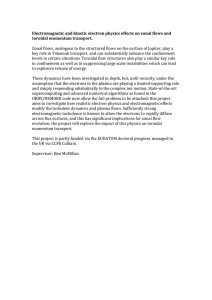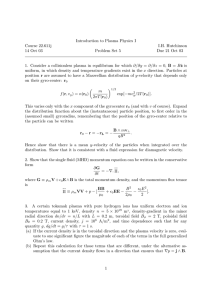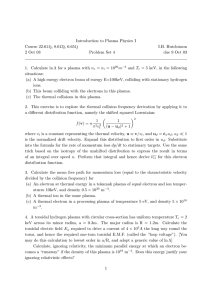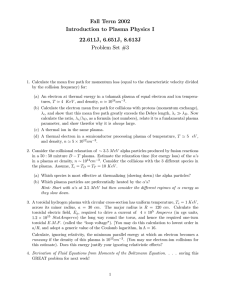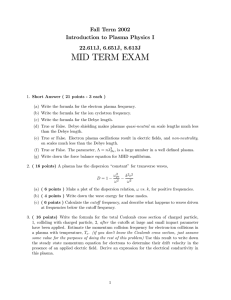Observation of toroidal and vertical currents in EC heated plasmas
advertisement
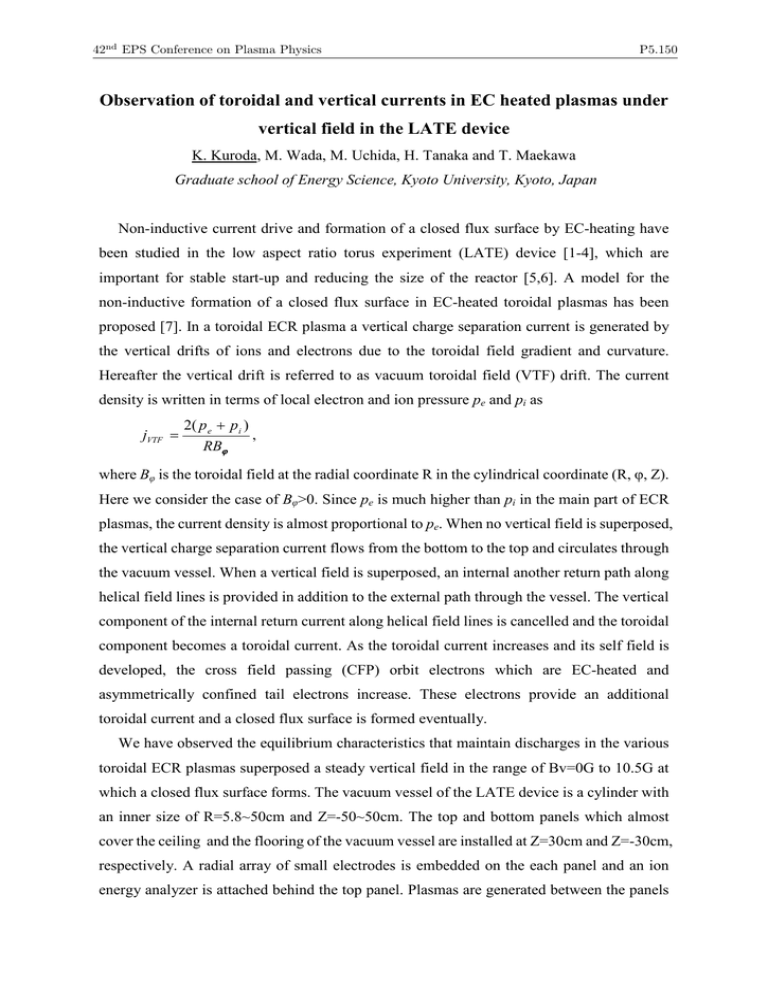
42nd EPS Conference on Plasma Physics
P5.150
Observation of toroidal and vertical currents in EC heated plasmas under
vertical field in the LATE device
K. Kuroda, M. Wada, M. Uchida, H. Tanaka and T. Maekawa
Graduate school of Energy Science, Kyoto University, Kyoto, Japan
Non-inductive current drive and formation of a closed flux surface by EC-heating have
been studied in the low aspect ratio torus experiment (LATE) device [1-4], which are
important for stable start-up and reducing the size of the reactor [5,6]. A model for the
non-inductive formation of a closed flux surface in EC-heated toroidal plasmas has been
proposed [7]. In a toroidal ECR plasma a vertical charge separation current is generated by
the vertical drifts of ions and electrons due to the toroidal field gradient and curvature.
Hereafter the vertical drift is referred to as vacuum toroidal field (VTF) drift. The current
density is written in terms of local electron and ion pressure pe and pi as
jVTF =
2( p e + p i )
,
RBϕ
where Bφ is the toroidal field at the radial coordinate R in the cylindrical coordinate (R, φ, Z).
Here we consider the case of Bφ>0. Since pe is much higher than pi in the main part of ECR
plasmas, the current density is almost proportional to pe. When no vertical field is superposed,
the vertical charge separation current flows from the bottom to the top and circulates through
the vacuum vessel. When a vertical field is superposed, an internal another return path along
helical field lines is provided in addition to the external path through the vessel. The vertical
component of the internal return current along helical field lines is cancelled and the toroidal
component becomes a toroidal current. As the toroidal current increases and its self field is
developed, the cross field passing (CFP) orbit electrons which are EC-heated and
asymmetrically confined tail electrons increase. These electrons provide an additional
toroidal current and a closed flux surface is formed eventually.
We have observed the equilibrium characteristics that maintain discharges in the various
toroidal ECR plasmas superposed a steady vertical field in the range of Bv=0G to 10.5G at
which a closed flux surface forms. The vacuum vessel of the LATE device is a cylinder with
an inner size of R=5.8~50cm and Z=-50~50cm. The top and bottom panels which almost
cover the ceiling and the flooring of the vacuum vessel are installed at Z=30cm and Z=-30cm,
respectively. A radial array of small electrodes is embedded on the each panel and an ion
energy analyzer is attached behind the top panel. Plasmas are generated between the panels
42nd EPS Conference on Plasma Physics
P5.150
using 2.45GHz microwave pulse of 2s. The toroidal field is Bφ=480G at R=25cm in all
discharges.
Figure 1 shows plasma images captured by a CCD camera, plasma profiles measured by
Langmuir probes, the toroidal current profiles obtained by signals of thirteen flux loops
surrounding the vessel (refer to P5 149 in this conference [8]) and radial profiles of the vertical
circulation current flowing to the top and bottom panels measured by the radial arrays and ion
current flowing to the top panel measured by the ion analyzer in the discharges with
Pinj=1.5kW and Bv=0G, 2.7G, 6.8G and with Pinj=2.0kW and Bv=10.5G, respectively. Here
Bv denotes the Z-component of external field at R=22cm. The toridal current flowing in the
negative φ direction and vertical circulation current through the external path are generated. A
closed flux surface is observed in the discharge with Pinj=2.0kW and Bv=10.5G.
In the case of Bv=0G, a vertically uniform electron pressure ridge drives a vertically
uniform current by the electron VTF drift and a space potential hill which crosses the field and
shifts upward regulates the drift flows of electrons and ions without accumulating charges. [9]
Figure 1 (a) CCD plasma images. (b) Plasma profiles of electron density (ne), temperature (Te) and pressure
(pe) and space potential (Vs). The data are not shown when the disturbance of a interferometer line density of
the chord Rt=12cm becomes more than 10% by probe insertion. (c) Toroidal current profiles. (d) Radial
profiles of vertical circulation current densities on the top and bottom, jtop array and jbottom array, and ion current
density on the top, jion collector. The radial profiles are weighted by 2πR. ITP and IBP are total amounts of current
on the top and bottom. Iion is a estimated total amount of ion current on the top.
42nd EPS Conference on Plasma Physics
P5.150
In the case of Bv=6.8G and 10.5G, as shown in Fig. 1(d), the negative current flowing at
R~18cm on the top panel shows there are more electrons flowing along field lines to the panel
than the ions flowing by the drifts. The ion’s flow by the drift increase at R~32cm on the top
panel, where a steep potential slope forms, and ITP and IBP are balanced. The electron density
decreases near the bottom panel and the electron VTF drift current is low relative to the current
flowing to the panel. The result shows the electron’s flow along field lines to the bottom panel
decreases the electron density near the panel and the flow contributes to the toroidal current
which is opposite direction of the toroidal current in the main part.
The main electron’s flow changes from the flow by the drifts across the field to the flow
along helical field lines by superposing a week vertical field and the plasma profiles change
drastically. The space potential hill across field at Bv=0G is relaxed significantly at Bv=2.7G
as shown in Fig. 1(d). Along helical field lines, the electron temperature becomes uniform and
the density obeys the Bolzman’s law “ne ∝ exp{VS/Te}” at Bv=6.8G and 10.5G as shown in
Fig. 2 . On the other hand ion’s flow along helical field lines is much slower than the flow by
E×B drift, which is simulated by ion particle orbits (refer to P5 149 in this conference [8]).
Figure 2 Profiles of electron density and temperature, space potential and the value of Boltzmann’s law
“exp{eVs/Te}” along field lines (a) A and (b) B in Fig 1(b) in the discharge with Pinj=1.5W and Bv=6.8G.
Figure 3(a) shows that the toroidal current increases linearly with Bv up to Bv=6.8G and
increases furthermore at Bv=10.5G where a closed flux surface is formed, while the vertical
circulation current is almost constant at about 2A at Bv=0~6.8G and decreases to about 1A
after formation of a closed flux surface. The ballooning force of plasma pressure is balanced
with the counter forces by the interaction of the toroidal current and the vertical circulation
current with the field. Figure 3(b) shows the counter forces roughly estimated as follows (for
detailed analyses, refer to P5 149 in this conference [8]).
FCF [ I ϕ × BZ ] = I ϕ × BV × 2π × 0.25m
FCF [ I Z × Bϕ ] = I BP × 0.048T × 0.6m
42nd EPS Conference on Plasma Physics
P5.150
The former force due to the toroidal current is estimated using the current of Iφ, the field strength
of Bv and the current path length of 2π × 0.25m and the later force due to the vertical circulation
current is estimated using the current of IBP, the field strength of 480G that is Bφ at R=25cm and
the current path length of 60cm that is the plasma height. While the ballooning force of plasma
pressure is balanced by only FCF [IZ×Bφ] due to the vertical current at Bv=0G, FCF [Iφ×BZ]
increases much larger than FCF [IZ×Bφ] at Bv>5G. The plasma becomes mainly maintained by
the toroidal current and the pressure profile should change depending on the toroidal current.
Figure 1 shows that as Bv is increased, the electron pressure and the plasma image change from
cylindrical profiles to spherical profiles and spread outward in corresponding to the increasing
toroidal current and the spreading area of the current profile. The line integrated density along
the chord of Rt=12cm increases as shown in Fig. 3(a) and the peaks of electron density,
temperature and pressure also rise with increasing the toroidal current as shown in Fig. 1.
Figure 3 Changes with Bv of (a) the line integrated densities along the mid-plannes chord of Rt=12cm and
Rt=28cm, toroidal current, Iφ and vertical circulation current on the top and bottom panels, ITP and IBP, and (b)
roughly estimated counter forces by “Iφ×BZ” and “IZ×Bφ”.
Acknowledgements
The present work was supported by KAKENHI (Grant Number 23360411 and 26289357).
References
[1] M. Uchida, T. Maekawa, H. Tanaka, S. Ide, Y. Takase et al., Nucl. Fusion. 51 (2011) 063031
[2] T. Yoshinaga, M. Uchida, H. Tanaka and T. Maekawa, Phys. Rev. Lett. 96 (2006) 125005
[3] T. Maekawa, T. Terumichi, H. Tanaka et al., Nucl. Fusion. 45 (2005)1439
[4] S. Nishi, T Sakabe, M. Uchida, H. Tanaka and T. Maekawa, Plasma Phys. Control. Fusion 96 (2010) 125004.
[5] S. Nishio et al., Proc. 20th Int. conf. on Fusion Energy 2004 (Vilamoura Portugal) (Vienna: IAEA) CD-ROM
file FT/P7-35 and http://www-naweb.iaea.org/napc/physics/fec/fec2004/datasets/index.html.
[6] K. Tobita et al., Fusion Eng. Des. 81 (2006) 1151.
[7] T. Maekawa, T. Yoshinaga, M. Uchida, F. Watanabe and H. Tanaka Nucl. Fusion. 52 (2012) 083008.
[8] T. Maekawa et al, 42nd EPS Conference on Plasma Phys. Lisbon, P5.149 (2015).
[9] K. kuroda, M. Wada, M. Uchida, H. Tanaka and T. Maekawa, Plasma Phys. Control. Fusion 57 (2015) 075010.
